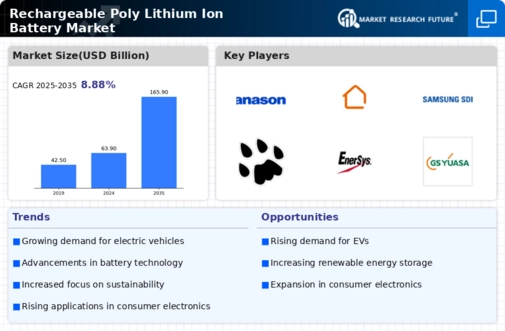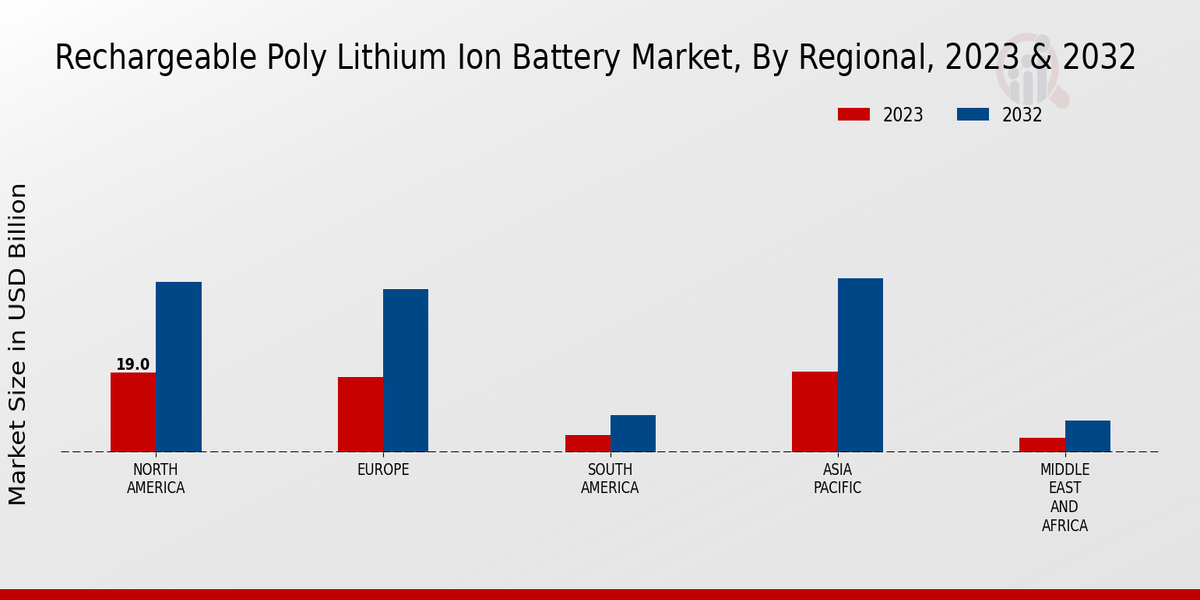Market Growth Projections
The Global Rechargeable Poly Lithium Ion Battery Market Industry is poised for substantial growth, with projections indicating a market value of 63.9 USD Billion in 2024 and an anticipated increase to 165.9 USD Billion by 2035. This growth trajectory suggests a compound annual growth rate of 9.06% from 2025 to 2035. Factors contributing to this expansion include the rising demand for portable electronics, advancements in battery technology, and the increasing adoption of electric vehicles. The market's evolution reflects broader trends in sustainability and technological innovation, positioning it as a critical component of the global energy landscape.
Advancements in Battery Technology
Technological advancements play a crucial role in shaping the Global Rechargeable Poly Lithium Ion Battery Market Industry. Innovations in battery chemistry and design have led to improved energy density, charging speeds, and overall performance. For instance, the development of solid-state batteries promises enhanced safety and efficiency, potentially revolutionizing the market. As manufacturers invest in research and development, the industry is likely to witness a compound annual growth rate of 9.06% from 2025 to 2035. This continuous evolution in battery technology not only meets consumer demands but also aligns with the growing emphasis on sustainability and environmental responsibility.
Rising Adoption of Electric Vehicles
The transition towards electric vehicles (EVs) significantly influences the Global Rechargeable Poly Lithium Ion Battery Market Industry. As governments worldwide implement stringent emission regulations and promote green transportation, the demand for lithium-ion batteries in EVs escalates. In 2024, the market's valuation of 63.9 USD Billion reflects the increasing integration of these batteries in electric cars. By 2035, the market is projected to expand to 165.9 USD Billion, driven by the growing consumer acceptance of EVs and advancements in charging infrastructure. This shift not only enhances battery demand but also contributes to a more sustainable automotive ecosystem.
Government Initiatives and Incentives
Government initiatives and incentives play a pivotal role in shaping the Global Rechargeable Poly Lithium Ion Battery Market Industry. Many countries are implementing policies to promote the use of lithium-ion batteries in various applications, including electric vehicles and renewable energy storage. These initiatives often include financial incentives, subsidies, and research grants aimed at fostering innovation and adoption. As a result, the market is projected to grow from 63.9 USD Billion in 2024 to 165.9 USD Billion by 2035. Such supportive measures not only stimulate demand but also encourage manufacturers to invest in sustainable practices and technologies.
Growing Demand for Portable Electronics
The Global Rechargeable Poly Lithium Ion Battery Market Industry experiences a surge in demand driven by the proliferation of portable electronic devices. As consumers increasingly rely on smartphones, tablets, and laptops, the need for efficient and long-lasting batteries becomes paramount. In 2024, the market is valued at 63.9 USD Billion, reflecting the significant role of lithium-ion batteries in powering these devices. This trend is expected to continue, with projections indicating that by 2035, the market could reach 165.9 USD Billion. The increasing adoption of smart devices across various demographics further underscores the potential growth in this sector.
Increased Focus on Renewable Energy Storage
The Global Rechargeable Poly Lithium Ion Battery Market Industry is significantly impacted by the rising focus on renewable energy storage solutions. As the world shifts towards sustainable energy sources, the need for efficient energy storage systems becomes critical. Lithium-ion batteries are increasingly utilized in solar and wind energy applications, allowing for the storage and management of energy generated from renewable sources. This trend is expected to drive market growth, with projections indicating a compound annual growth rate of 9.06% from 2025 to 2035. The integration of these batteries into energy systems not only enhances grid stability but also supports the global transition to cleaner energy.

























Leave a Comment